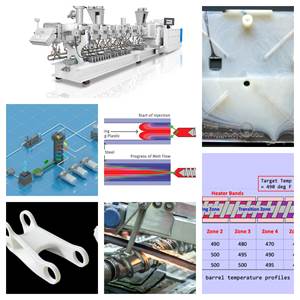Outfitting Your Lab: Part I - How to Buy Melt Indexers
This first installment in a series on buying commonly used lab equipment highlights how computerization and automation have improved the accuracy and repeatability of melt-flow testing.
Among the first instruments plastics molders, extruders, and compounders are likely to consider when outfitting a new lab is a melt-flow indexer or “melt indexer.” Known as an extrusion plastometer in more technical jargon, this apparatus has long been used to determine the melt-flow rate or mass-flow rate (MFR) of virgin and compounded thermoplastic resins. With the increased pressure on plastics processors to comply with ISO 9000 standards for quality management, more of them than ever are using these instruments to evaluate incoming material and test finished products.
The melt-flow test detailed in the ASTM D1238 and ISO 1133 standards quickly measures one point on the viscosity curve under standard conditions. While the relative simplicity of this test has remained the same, melt indexers have evolved considerably since they appeared in the 1950s. Computerization and automation have reduced operator-to-operator variables, yielding results with greater accuracy and repeatability.
Why measure melt index?
The melt indexer consists of a heated barrel and piston assembly to contain a sample of resin. A specified load (weight) is applied to the piston, and the melted polymer is extruded through a capillary die of specific dimensions. The mass of resin, in grams, that is extruded in 10 minutes equals the MFR, expressed in units of g/10 min. (This value is also commonly called the melt index, MI, or melt-flow index, MFI.) Some instruments can also calculate the shear rate, shear stress, and viscosity in centipoise.
The basic property measured by the melt flow test is the melt viscosity or flow resistance of the polymer at a particular shear stress (related to the applied load) and temperature. Polymer chains of short length and simple geometry “slide” past one another relatively easily and offer little flow resistance. In contrast, long chains of high molecular weight and more complex structure yield greater flow resistance or viscosity.
The MFR, then, is an indicator of average molecular weight and is inversely related to it. “A resin with an MFR of 50 g/10 min indicates a lower molecular weight than one with an MFR of 10 g/10 min. While a higher MFR material may be easier to process, physical properties related to molecular weight, such as impact resistance, are often lower,” says Allen Zielnik, general manager of polymer evaluation products at Atlas Electric Devices, one maker of melt indexers.
Thus, MFR is commonly used as a material-acceptance specification by processors and also as a means of comparing resins from different vendors. As Zielnik points out, it also has many uses in quality control. Not only can variations in polymerization and compounding affect MFR of incoming resin, but it is also a valuable indicator of resin degradation caused by transport or storage conditions or improper drying. Regular MFR testing after molding or extrusion can help pinpoint improper processing conditions. It also provides a simple indicator of how addition of in-plant regrind or post-consumer reclaim may affect the virgin resin’s processability and end-use performance.
Zielnik offers an actual case of how this information can be used: An injection molded polycarbonate part was found to crack when dropped. The virgin resin had an MFR of 28.5 g/10min. A sample from a known “good” lot of parts was ground up and tested in a melt indexer. It had an MFR of 27, well within established tolerances (±30%). But a “problem” part showed an MFR of 90. From this evidence, it was discovered that the “bad” lot contained a large amount of regrind that had been thermally degraded in processing.
However, makers of melt indexers warn that MFR data have one fundamental limitation: The test is performed at a very low shear rate (about 0.5 to 200 sec-1). While this shear rate may accurately reflect how “stiff” a melt is in low-shear processing, such as in calendaring or compression molding, it is usually unrepresentative of melt behavior under the higher shear of injection molding (around 10,000 to 100,000 sec-1) or extrusion (around 100 to 1000 sec-1). To more accurately characterize processability under higher shear conditions, processors should consider buying a capillary rheometer. It measures multiple points on the shear rate/viscosity curve. While typically more expensive than a melt indexer, some of these instruments can be purchased for under $40,000.
Which method to use?
ASTM 1238 and the ISO 1133 test methods are “technically equivalent” but there are some minor differences. “The way the test is run is different, as are some technical specifications, which can lead to different results,” says Tim Haake, general manager of Goettfert, another instrument supplier. He is among the participants in rewriting ASTM 1238 so that it is more harmonious with the ISO norm. He also notes, “better melt indexers can run either test by flipping a switch.”
Both ASTM 1238 and ISO 1133 offer two variations of the standard melt-flow test: Method A and Method B. Method A describes a basic manual melt indexer. It involves making “cuts” of the extrudate at timed intervals as it exits the extrusion die. The “cuts” are weighed on an analytical balance to determine the average mass and this value is extrapolated to the mass that would be extruded in 10 minutes—the MFR. Weights range from 1.2 to 21.6 kg to permit measuring materials ranging from very low to very high viscosity (more viscous melts require more weight to force them through the die). The load and temperature to be used are determined by the material and the ASTM test method.
With most Method A instruments, only temperature is automatically controlled. All the measurement is done by the operator. “Picture an operator holding a stop watch in one hand and a cutter in the other—that is the basic Method A instrument,” says Gerard Nelson, area sales manager for CEAST USA.
All new melt indexers today are provided with automatic timers, and some have automatic extrudate cutters. Although the latter work well with some plastics, Zielnik from Atlas cautions that some resin melts are sticky or difficult to manipulate to obtain a clean cut. “In many cases, automatic cutters cannot match the human hand,” he says. Basic Method A instruments typically are priced in the $3000-5000 range.
Method B testing is simpler in that there is no extrudate cutting or weighing because it is volumetric. The volume of the resin extruded is obtained from the geometry of the barrel and distance of piston travel over a measured time period. This determines the mass volume rate (MVR) in cc/10 min. From this value and the resin’s melt density, the MFR can be calculated automatically. With Method B testing, the operator simply loads the barrel with resin, starts the test, and the instrument calculates the results. Semi-automatic units have a sensor that detects where the piston is at any moment.
“This is the first advantage over basic Method A instruments,” says Haake from Goettfert. “These units measure 20, 30, or 40 measurement points in one test run and statistically calculate which results are within the norm and which are outside the norm due to an air bubble or other impurities. The second advantage is that there is less user interference. Results, then, are generally more accurate and more reproducible,” he explains.
On the other hand, Method B testing requires an accurate value for the resin melt density at the test temperature. Such values are available in published literature—for example, typical values for “generic” PE and PP are cited in the ASTM 1238 standard. However, most sources consider it more accurate to measure the actual melt density of the specific resin being tested. This is done by combining elements of Method A and Method B in a single test run so as to obtain data for both weight and volume—hence, density. Today’s melt indexers for Method B can be used to perform both tests. If desired, an automatic extrudate cutter could be added to the Method B instrument.
There is no general consensus as to which procedure is best. Some, like Atlas’s Zielnik, recommend Method A for most processors: “It tests the ‘bulk property’ of the material and does not presume that you know or trust a stated melt-density value for the actual resin,” he explains.
Others, like Tinius Olsen marketing manager Harry Yohn, view Method A as best for compounders who use a broad range of materials and additive packages. He sees Method B as best suited to labs that make frequent measurements of the same type of material with a known melt density.
Nelson at CEAST says processors working with very low-MFR resins (under 0.5 g/10 min) are best off with Method B—provided the instrument has a digital encoder to measure piston movement. “With polymers of such low flow rate, there is virtually no material extruded, and the piston hardly moves at all. To rely on a manual cut or a visual determination of how far the piston has moved leaves too much room for error. A digital encoder takes care of the problem.” The same goes for very high-flow-rate materials (over 75 g/10 min), according to Yohn.
There is also a multi-weight melt flow test, which unlike standard Method A and Method B, provides more than one measurement on a single charge under two or three different load conditions (using different weights). The multi-weight test is referenced under ASTM D1238 as a variation of the melt-flow test, but instrument suppliers are working to write a separate standard for this test.
Several suppliers offer multi-weight capability. In an instrument that can calculate shear rate and viscosity in addition to MFR, multi-weight measurement provides the equivalent of a “poor man’s capillary rheometer,” suppliers say.
Most suppliers agree that multi-weight instruments are mainly suitable for use by resin producers or compounders who want to provide their customers with more information on how a material will behave. But Richard Pavero, president of Dynisco Polymer Test, says the multi-weight test can be quite helpful to blow molders of HDPE because it gives an indication of melt elasticity.
More & better features
Basic Method A or B melt indexers are priced in the range of $8000-15,000. Some models have additional features that push the price up to $30,000. There are also robotic melt indexers, which are said to achieve maximum accuracy but cost over $100,000. Companies such as Goetffert and Haake offer robotic systems primarily to resin producers.
Price differences reflect mainly options. Temperature controls may include an automatic preheat phase as either standard or optional. Digital encoders are available to measure piston travel for Method B with much higher precision than the older optical technology using photocells. The latter can take 12 data points in 1 in. of piston travel, but a digital encoder can take up to 40 data points per inch.
Motorized lifting and lowering the weight onto the piston is another newer option. This feature can add up to $3500 to the cost of the unit. Some units with pneumatic weight lifting/lowering can be had for about half the cost of motorized units. While they require a compressed-air source, they have fewer parts to wear than electric models.
Other new options include automatic compaction of the resin pellets before heating. Manually tamping down the material with a rod can account for as much as 10% variation in MFR results, according to CEAST’s Nelson. That variation is reportedly eliminated by a motor-driven rod whose force can be precisely controlled. This feature is supplied on CEAST’s new model MFT 130 instrument.
In addition, some units include safety shields around the piston and the automatic weight-lifting system. Some models show only numbers on a digital display while others have built-in printers or can be hooked up to an external printer.
Some suppliers, like Tinius Olsen, Haake, and Dynisco, take a modular or building-block approach, which permits adding capabilities to a basic unit after purchase. For example, Dynisco offers an $8000 model equipped with a digital encoder that can perform Method A and B testing. Adding features like motorized weight lifting and automatic preheating brings the price closer to $12,000.
Complete melt-flow testing systems can include a PC, Windows-based software for data storage and graphic data display, and a printer. One example is the Meltflixer HT, Haake’s high-end system, costing $20,000-30,000.
Besides option packages, price differences among melt indexers also have to do with the way the units are manufactured and calibrated. While technical specs are prescribed by ASTM, some suppliers just meet them, while others exceed them. A key point when buying a melt indexer is that temperature control must be absolutely stable. For example, some units have two heating elements around the barrel, while others only have one. Also, some have smaller ovens (the cylindrical block that surrounds the barrel), which means insulation and heat retention are not as good. A bigger oven around the barrel will allow temperature to stabilize more quickly.
Suppliers also say calibration is critical to proper use of a melt indexer, and they recommend that buyers make sure their vendor offers calibration services.Calibration requires checking the temperature inside the barrel at a specific point above the die, and also confirming the dimensions of the barrel, piston, and die.
Finally, the die, piston, and barrel must be easily cleanable. “Old polymer left in a barrel or die will degrade and cause large variations in MFRs,” says Dynisco’s Pavero. Some units have been designed for easier access, with simple die-release slides and swing-out ovens (the latter especially recommended with units that have automatic weight lifting). Automation goes even further with robotic systems that have integrated bar-code readers and cleaning systems that burn out and clean out dies.
Related Content
NOVA’s BOPE-HD Film Resin Gains in Globally Available Flexible Food Packaging Applications
Positioned as a recyclable packaging alternative to traditional BOPET films, BOPE-HD film is now available from companies such as Inteplast, JK Materials, Oben Group, and Polivouga.
Read MoreOMV Technologies Gets New CEO
Kooper brings 33 years of experience in the industrial and consumer packaging industries to OMV--the closed-loop, turnkey, inline extrusion, thermoforming and tooling systems manufacturer.
Read MorePlastics Technology’s Most-Viewed Articles from 2022
Tips, new technologies, resin pricing, best practices and more piqued reader interest at Plastics Technology in 2022.
Read MoreSD Polymers: 'One-Stop Solution for Mechanical Recycling'
‘Passionate’ recycler invests in people and technology to meet commitment to innovative, sustainable solutions for its processor customers.
Read MoreRead Next
People 4.0 – How to Get Buy-In from Your Staff for Industry 4.0 Systems
Implementing a production monitoring system as the foundation of a ‘smart factory’ is about integrating people with new technology as much as it is about integrating machines and computers. Here are tips from a company that has gone through the process.
Read MoreLead the Conversation, Change the Conversation
Coverage of single-use plastics can be both misleading and demoralizing. Here are 10 tips for changing the perception of the plastics industry at your company and in your community.
Read More



























